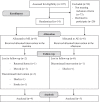Does the time of day differently impact the effects of an exercise program on postural control in older subjects? A pilot study
- PMID: 35443695
- PMCID: PMC9022324
- DOI: 10.1186/s13102-022-00467-5
Does the time of day differently impact the effects of an exercise program on postural control in older subjects? A pilot study
Abstract
Background: The time of day that people exercise can potentially influence the efficiency of exercises for fall prevention in older adults. The present pilot study was conducted to explore the feasibility and effects of morning versus afternoon exercising on postural control in institutionalized older adults.
Methods: Nine older adults completed a 3-month multimodal exercise program in its entirety (14 participants were recruited at the beginning and were initially randomly separated into two groups). One group exercised in the morning (ME; n = 4) and the other in the afternoon (AE; n = 5). Postural control was assessed with a force platform at pre and post-intervention at the following times: 8 a.m., 11 a.m., 2 p.m. and 5 p.m.
Results: Postural control significantly improved only in the AE group post-intervention. Improvements in postural control in the AE group were mainly observed in the morning.
Conclusions: The afternoon would be the best period to implement exercise sessions dedicated to improve postural control in older subjects with benefits mainly observed in the morning. Further studies are needed with a larger sample in order to confirm these results.
Keywords: Aging; Balance; Chronobiology; Fall prevention; Physical activity.
© 2022. The Author(s).
Conflict of interest statement
The authors declare that they have no competing interests.
Figures
References
Grants and funding
LinkOut - more resources
Full Text Sources


